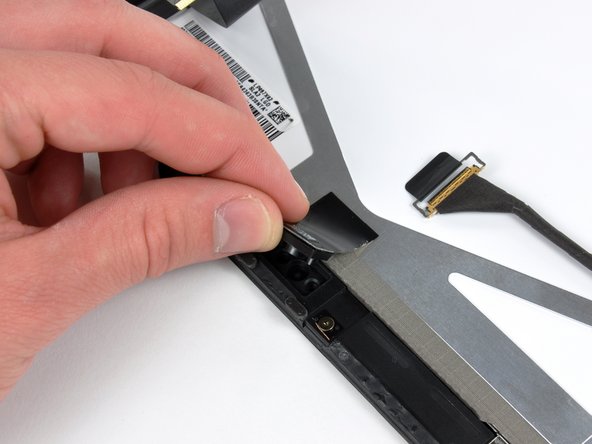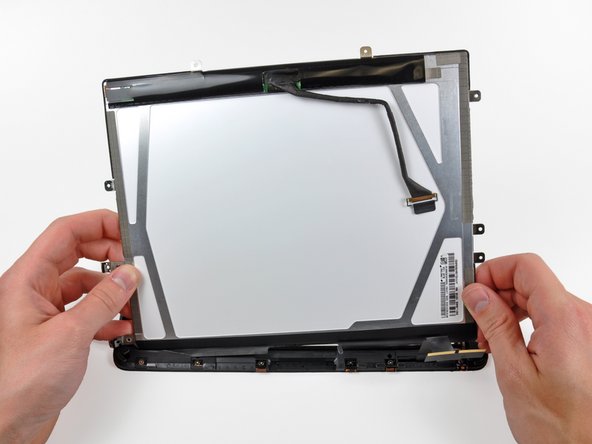Esta versión puede contener ediciones incorrectas. Cambie a la última instantánea verificada.
Qué necesitas
-
-
Si está agrietado el cristal de la pantalla, mantenga aún más la rotura contenida y prevenir daños físicos durante su reparación con cinta adhesiva el vidrio.
-
Coloque tiras de cinta adhesiva transparente sobre la pantalla del iPad se solapan hasta que toda la superficie está cubierta.
-
Haga todo lo posible para seguir el resto de la guía como se ha descrito. Sin embargo, una vez que el vidrio se rompe, es probable que continúe a agrietarse a medida que trabaja, y es posible que necesite usar una herramienta de palanca de metal para recoger el vaso.
-
-
Este paso está sin traducir. Ayuda a traducirlo
-
There are 14 metal clips holding the display assembly in place, shown at left. As you pry in the following steps, do your best to pry around these clips and not slice through them with your opening tool.
-
-
Este paso está sin traducir. Ayuda a traducirlo
-
Insert a metal spudger between the top edge of the display assembly and the rear panel assembly.
-
Rotate the spudger away from you to release the tabs along the top edge of the display.
-
Insert a second metal spudger between the top edge of the display assembly and the rear panel assembly to keep the tabs from snapping back into place.
-
-
Este paso está sin traducir. Ayuda a traducirlo
-
With one spudger, work your way along the right edge of the iPad.
-
The front panel is held to the aluminum back by metal clips on the top, bottom, and left sides. The right side has plastic tabs which slide into recesses in the backplate.
-
Once the clips are released, lift the left side of the front panel up and slide it to the left to clear the tabs from the aluminum backplate.
-
-
Este paso está sin traducir. Ayuda a traducirlo
-
Lift the display assembly away from the rear panel assembly by its bottom edge.
-
-
Este paso está sin traducir. Ayuda a traducirlo
-
In the following steps, you will disconnect the three cables attaching the display assembly to the logic board. The cables are for the following components:
-
Digitizer
-
Ambient Light Sensor
-
Display Data Cable
-
-
Este paso está sin traducir. Ayuda a traducirlo
-
Use the edge of a plastic opening tool to flip up the retaining flaps holding the digitizer ribbon cables in their sockets on the logic board.
-
Pull the digitizer ribbon cables straight out of their sockets.
-
-
-
Este paso está sin traducir. Ayuda a traducirlo
-
Use a plastic opening tool to remove the ambient light sensor connector from its socket by gently prying upward.
-
-
Este paso está sin traducir. Ayuda a traducirlo
-
Disconnect the display data cable from the main board by flipping up the metal retainer by its black plastic pull tab.
-
Pull the cable connector away from its socket.
-
-
Este paso está sin traducir. Ayuda a traducirlo
-
Remove the display assembly from the rear panel assembly.
-
-
-
Utilice el borde de una herramienta de apertura de plástico para hacer palanca con cuidado la placa del sensor de luz ambiental del adhesivo que lo sujeta al marco de la pantalla.
-
Una vez que haya ganado espacio suficiente, retire el sensor de luz ambiental de la pantalla LCD.
-
-
Este paso está sin traducir. Ayuda a traducirlo
-
While holding the digitizer cable down, carefully peel back the piece of tape connecting the digitizer cable to the display frame.
-
-
Este paso está sin traducir. Ayuda a traducirlo
-
Remove the three T5 Torx screws securing the clips and LCD brackets covered in EMI tape near the home button switch.
-
Carefully peel the display clip and its attached tape off the black plastic display frame.
-
-
Este paso está sin traducir. Ayuda a traducirlo
-
Remove the remaining T5 Torx screws securing the LCD to the black plastic display frame.
-
-
Este paso está sin traducir. Ayuda a traducirlo
-
Insert the edge of a plastic opening tool under one of the ears attached to the steel LCD frame.
-
Twist the plastic opening tool to gently pry the LCD up off the adhesive securing it to the front glass panel.
-
-
Este paso está sin traducir. Ayuda a traducirlo
-
Repeat the process detailed on the previous step to pry up the display around the three sides opposite the digitizer cable side of the display.
-
-
Este paso está sin traducir. Ayuda a traducirlo
-
Lift the LCD from its free end, and remove it from the display frame.
-
Carefully peel the adhesive securing the long side of the LCD to the display frame, then remove the LCD.
-
-
Este paso está sin traducir. Ayuda a traducirlo
-
If it is still stuck to the front panel, remove the strip of EMI tape near the ambient light sensor socket.
-
-
Este paso está sin traducir. Ayuda a traducirlo
-
If they are still in good shape, transfer the clips and EMI tape near the bottom of the LCD to your new LCD.
-
Cancelar: No complete esta guía.
79 personas más completaron esta guía.
4 comentarios
So what if ive snapped off one of the retaining flaps? Ive seen in the past when ive snapped them off before i could just plug it in, slap on some kapton tape and it was fine. This time i cant get the bottom of the digitizer to work on new glass. I put on the old glass and the bottom works just fine. the bottom flap is the one that broke, but why would the old glass work just fine, but the new glass does nothing on the bottom half?
Just replaced my lcd using this guide. Not easy, but doable. Took about an hour and a half. broke about half of the clips that hold the assembly in, but moved the remaining ones around so that it is secure. I recommend buying replacement clips if you aren't comfortable with that. Also, this guide says to use a Torx T5 screwdriver. Other sites say T4. It is most definitely T5. I bought the wrong one first and had to get a new one. Home Depot has an 8 in 1 Torx tool for 6 bucks that is great. Thank you iFixit for saving me hundreds that I would have spent on a new iPad!
Don't worry about buying more replacment clips -- if you still have them on the left edge, not having the clips on the top and bottom isn't noticeable.
Styg -
When reassembling at the last step (inserting the screen assembly into the back cover), do NOT simply do the reverse of what you did to take it out. Instead, insert the right edge first (with the plastic tabs). The metal tabs on the left edge (and top and bottom edges if you have any left) are flexible, so it is very easy to snap the left edge of the screen into the back cover AFTER the right edge is in place. If you put the left edge in first, you'll have a much tougher time trying to get the plastic tabs on the right edge into back cover.
































